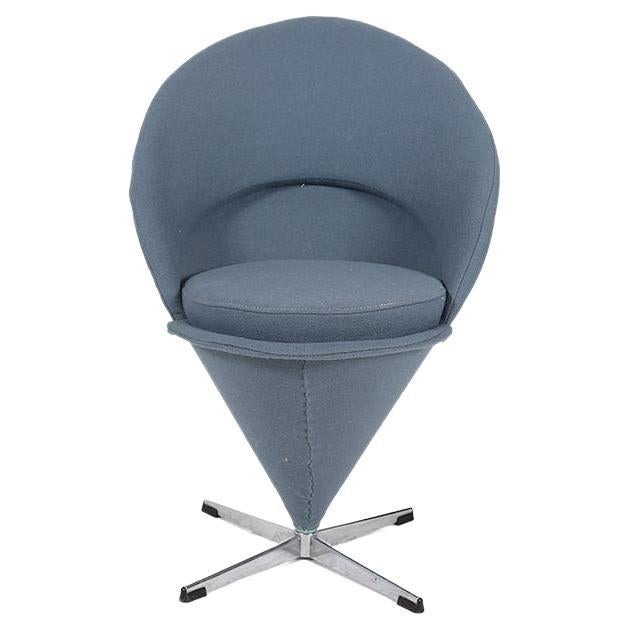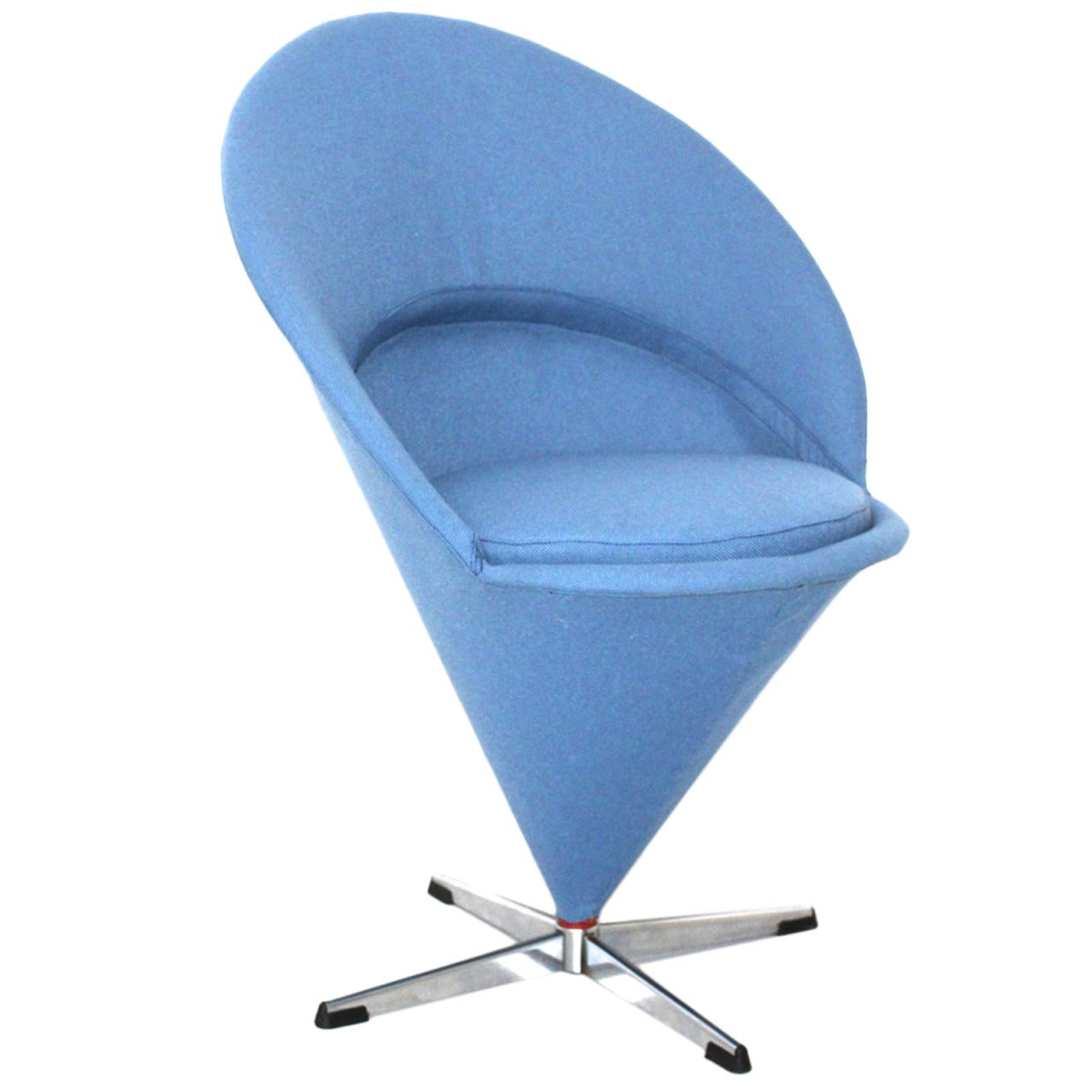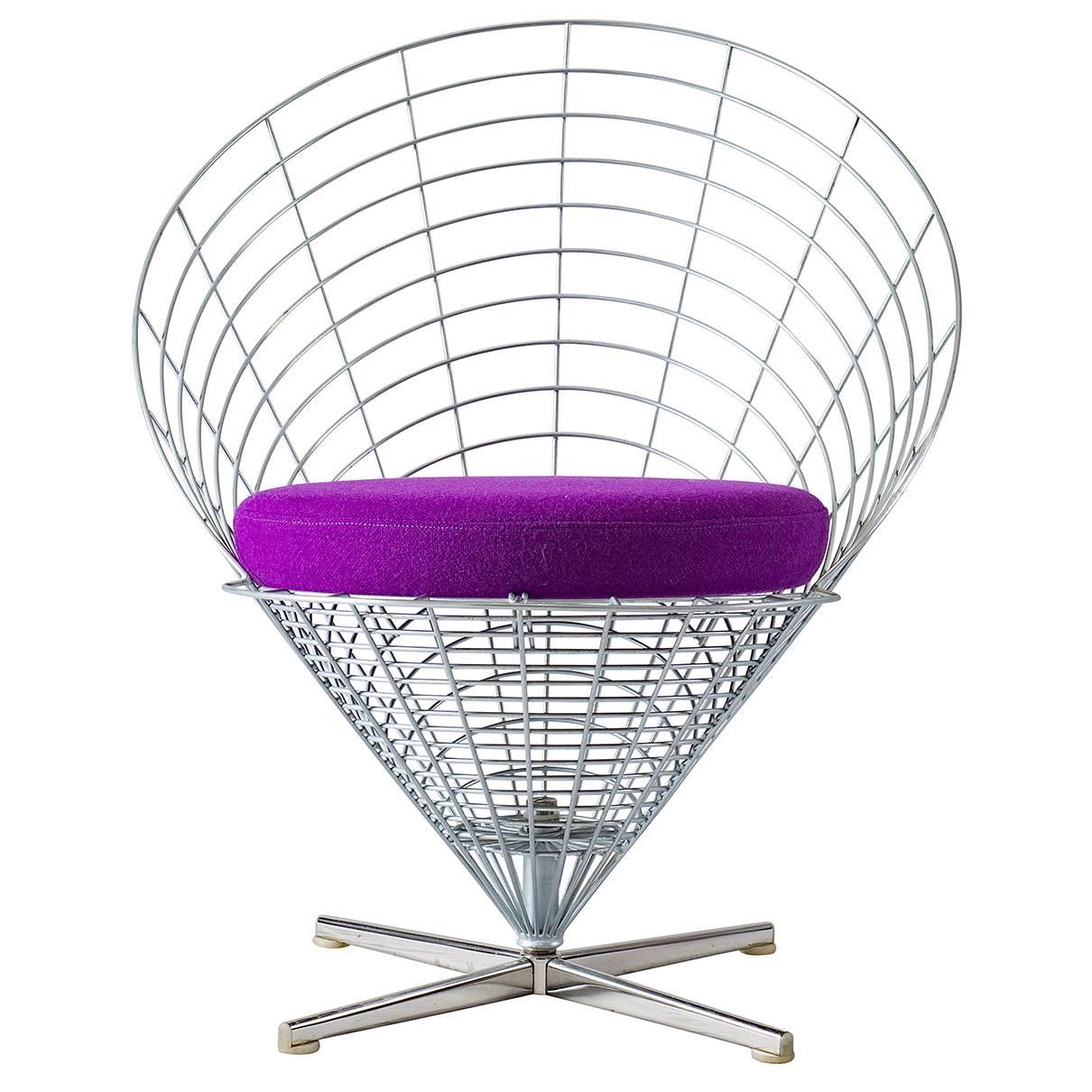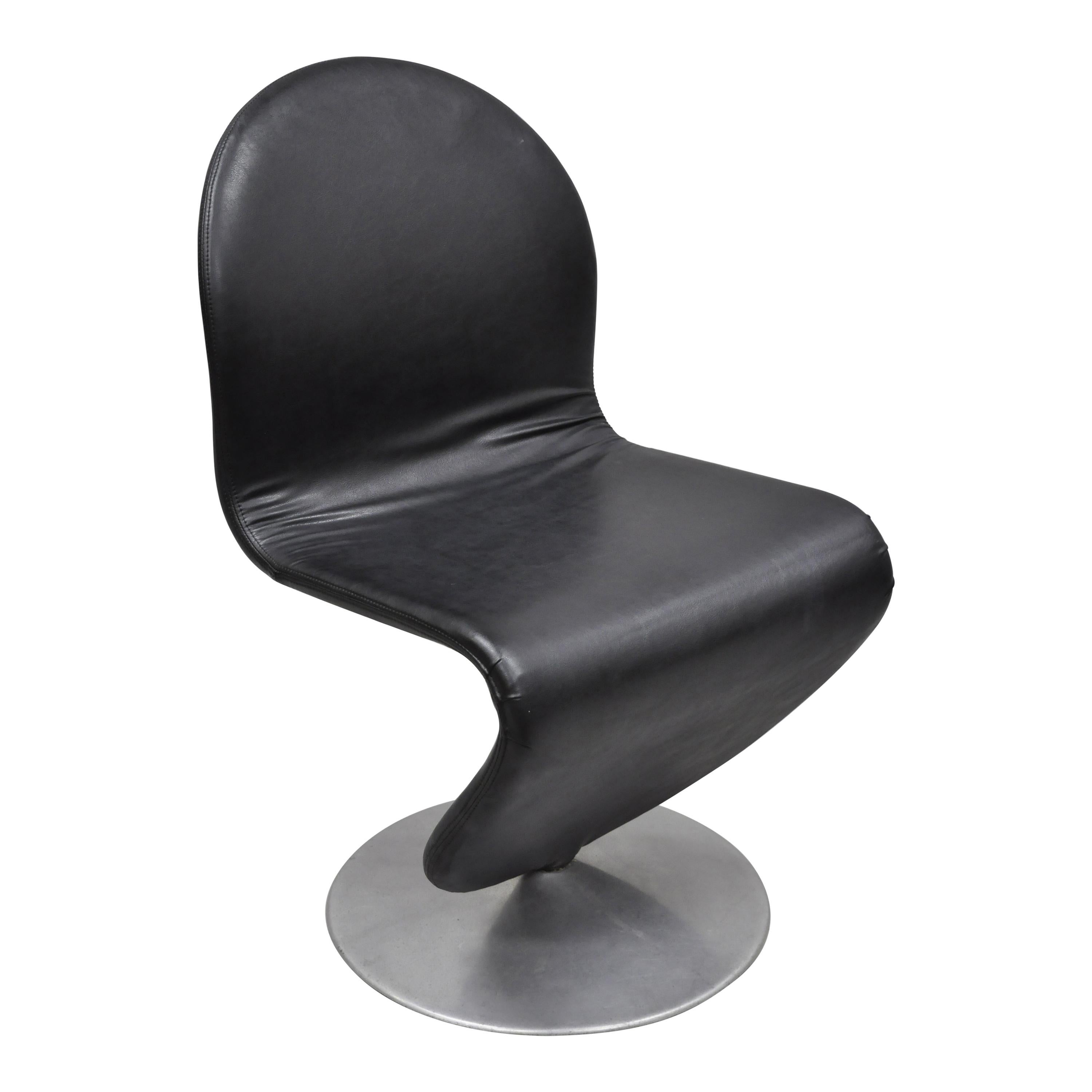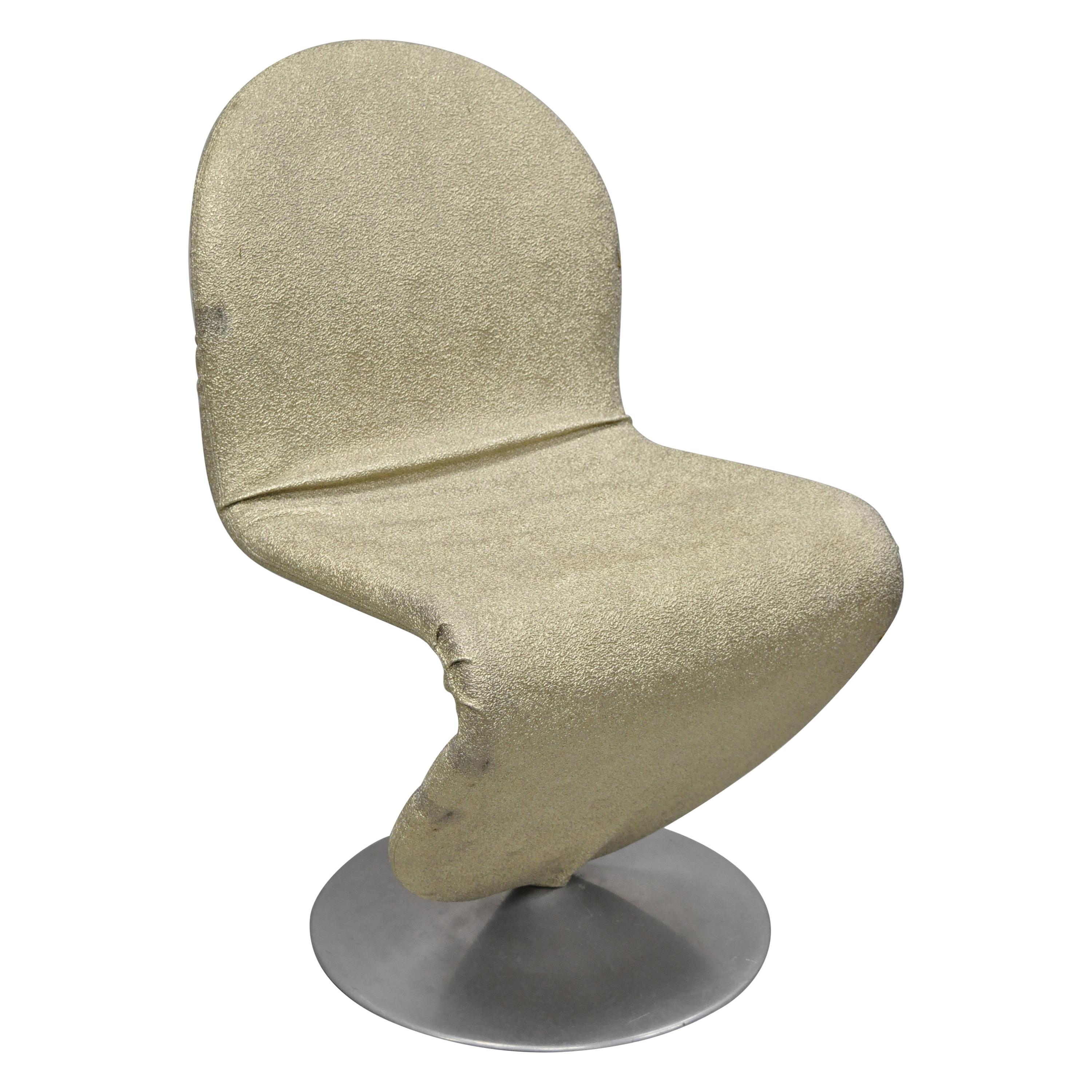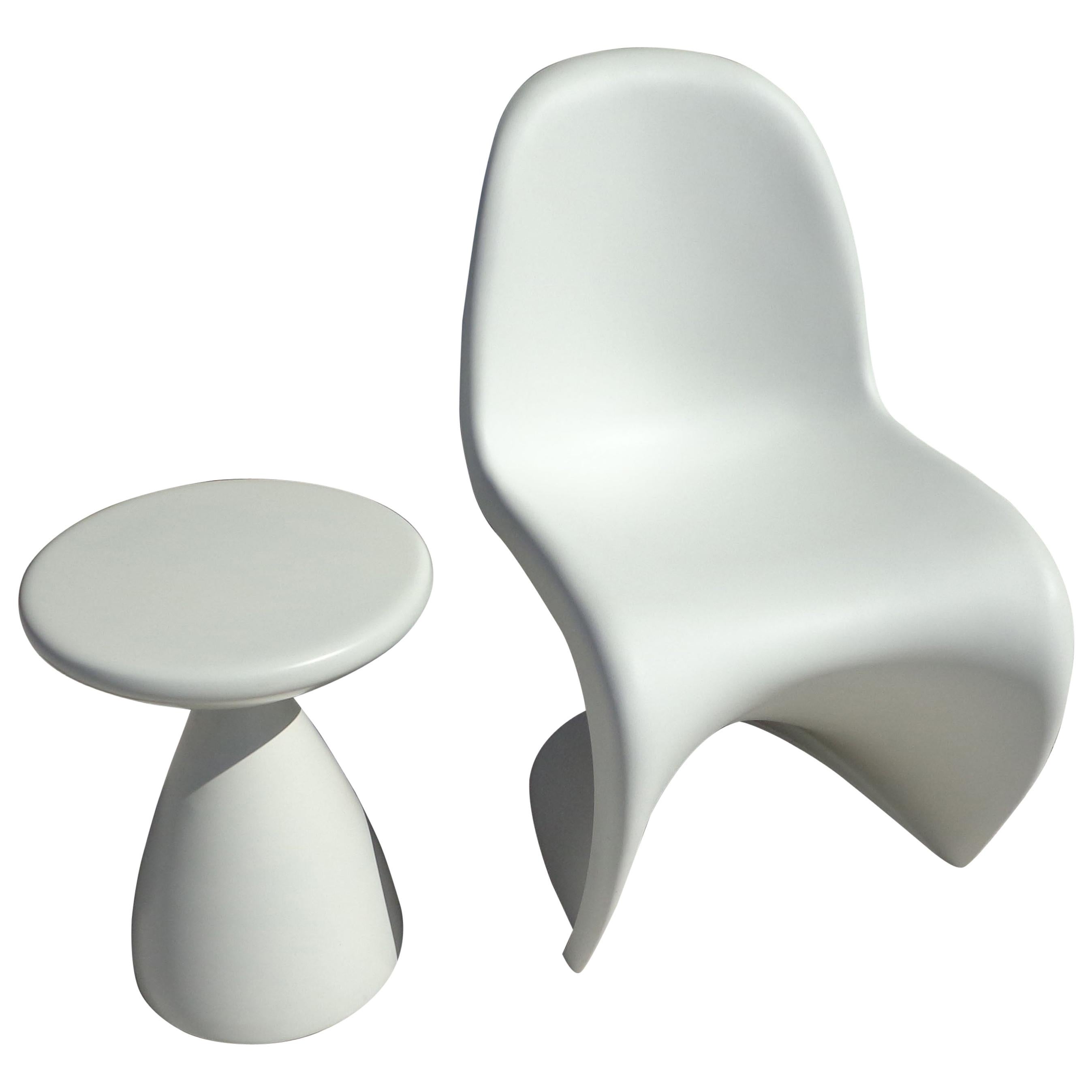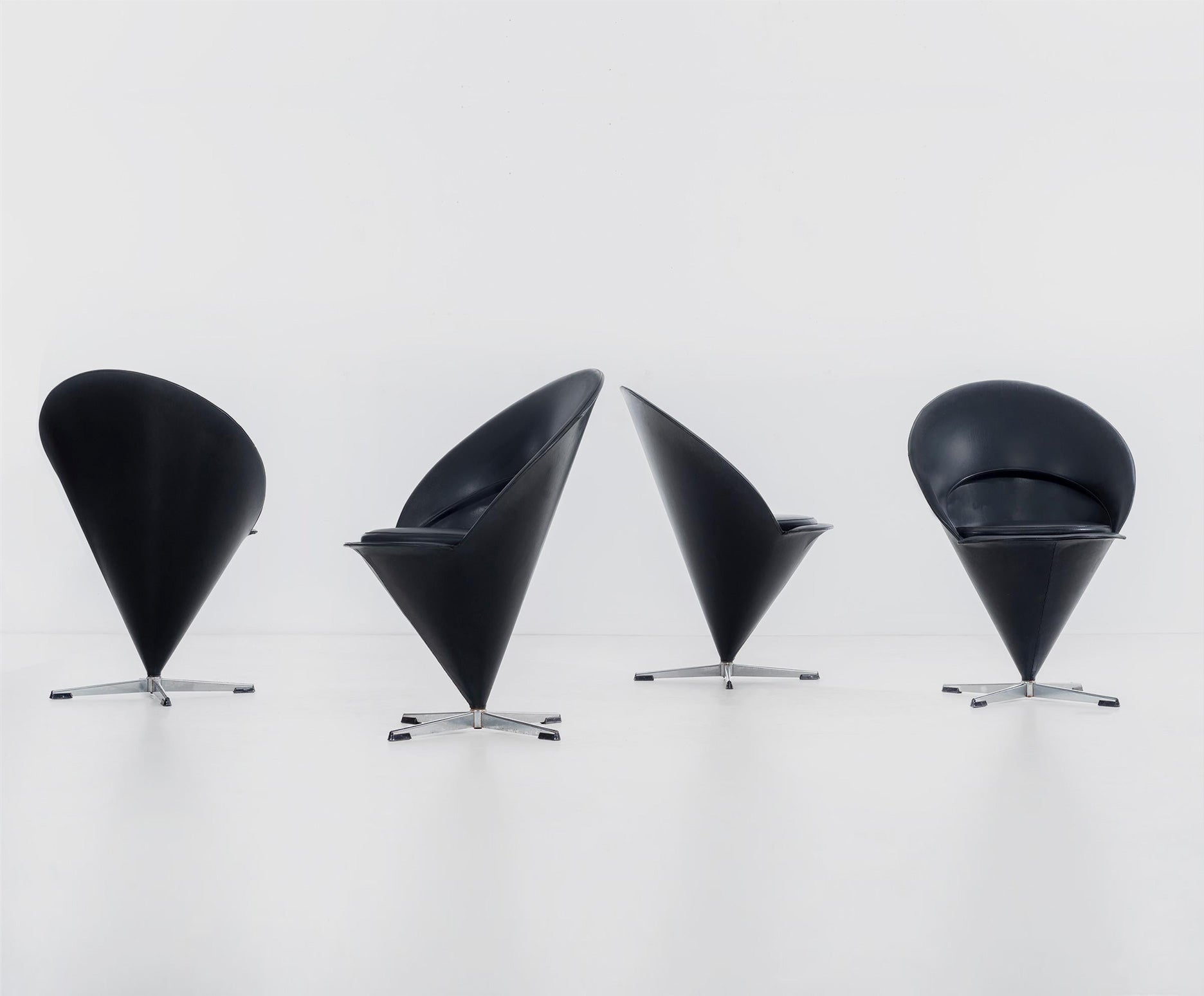Mid Century Modern Vintage Verner Panton Blue Velvet Cone Side Chairs Denmark
About the Item
- Creator:Verner Panton (Designer)
- Design:Cone ChairCone Series
- Dimensions:Height: 33.08 in (84 cm)Width: 23.23 in (59 cm)Depth: 24.02 in (61 cm)
- Sold As:Set of 2
- Style:Mid-Century Modern (Of the Period)
- Materials and Techniques:
- Place of Origin:
- Period:
- Date of Manufacture:1960s
- Condition:Refinished. Wear consistent with age and use. New cover with blue velvet fabric.
- Seller Location:Vienna, AT
- Reference Number:1stDibs: LU1069836417862
Cone Chair
Simple geometric shapes don’t often cause seismic shifts in furniture design. The bold Cone chair, conceived by mid-century Danish architect and designer Verner Panton (1926–98), however, brought about just such a transformation.
After graduating from Copenhagen’s Royal Danish Academy of Fine Arts in 1951, Panton secured a mentorship in the office of renowned architect Arne Jacobsen. There, he contributed to the development of Jacobsen’s revolutionary Ant chair. Slender, lightweight and stackable, with a one-piece laminated-veneer seat that rested on three plastic legs, the 1952 design mirrored the elegant form of its insect namesake. The Ant chair had a significant effect on Panton, who went on to explore the possibilities of Plexiglas and synthetics, rather than working in the solid teak and oak that occupied his contemporaries.
The influence of Jacobsen’s work is evident in Panton’s Cone chair, which he debuted at his father’s restaurant in southern Denmark in 1958, six years after leaving the architect’s office. The designer was revamping the eatery, and the chair — with its artful, pod-like shell set upon a stainless-steel swivel base and its comfortable seat upholstered in soft red fabric to comfort hungry diners — was a key element in his (typically radiant) overhauled interiors.
Panton’s renovation dazzled reporters and patrons, including entrepreneur Percy von Halling-Koch, who created a company to produce the Cone chair. Its unusual form — an inverted cone seeming to balance on its point — caused a sensation in Denmark and beyond. Displayed in a Manhattan store window, the chair incited such a furor on the city’s crowded streets that the police had the shop owners remove it from public view.
Today, Verner Panton's Cone chair is manufactured by Swiss furniture company Vitra and continues to delight design connoisseurs.
Verner Panton
Verner Panton introduced the word “groovy” — or at least its Danish equivalent — into the Scandinavian modern design lexicon. He developed fantastical, futuristic forms and embraced bright colors and new materials such as plastic, fabric-covered polyurethane foam and steel-wire framing. And Panton’s ebullient Pop art sensibility made him an international design star of the 1960s and ’70s. This radical departure from classic Danish modernism, however, actually stemmed from his training under the greats of that design style.
Born on the largely rural Danish island of Funen, Panton studied architecture and engineering at Copenhagen’s Royal Danish Academy of Fine Arts, where the lighting designer Poul Henningsen was one of his teachers. After graduating, in 1951, Panton worked in the architectural office of Arne Jacobsen, and he became a close friend of Hans Wegner's.
Henningsen taught a scientific approach to design; Jacobsen was forever researching new materials; and Wegner, the leader in modern furniture design using traditional woodworking and joinery, encouraged experimental form. Panton opened his own design office in 1955, issuing tubular steel chairs with woven seating. His iconoclastic aesthetic was announced with his 1958 Cone chair, modified a year later as the Heart Cone chair. Made of upholstered sheet metal and with a conical base in place of legs, the design shocked visitors to a Copenhagen furniture fair.
Panton went on to successive bravura technical feats. His curving, stackable 1960 Panton chair, his most popular design, was the first chair to be made from a single piece of molded plastic. Three years later, he introduced the S model, the first legless chair crafted from a single piece of plywood, cantilevered on a round metal base. Panton would spend the latter 1960s and early ’70s developing all-encompassing room environments composed of sinuous and fluid-formed modular seating made of foam and metal wire. He also created a series of remarkable lighting designs, most notably his Fun chandeliers — introduced in 1964 and composed of scores of shimmering capiz-shell disks — and the Space Age VP Globe pendant light of 1969.
As you will see from the offerings on 1stDibs, Verner Panton’s designs are made to stand out and put an eye-catching exclamation point on even the most modern decor.
- ShippingRetrieving quote...Ships From: Vienna, Austria
- Return PolicyA return for this item may be initiated within 3 days of delivery.
- Blue Scandinavian Modern Cone Chair or Side Chair by Verner Panton Denmark 1958By Verner PantonLocated in Vienna, ATBlue Scandinavian Modern cone chair or side chair by Verner Panton 1958 and executed by Gebr. Nehl, Germany. The cone swiveling body was made of steel and is fixed on a chromed stee...Category
Vintage 1950s Danish Mid-Century Modern Chairs
MaterialsSteel
- Mid Century Modern Vintage Metal Teak Coffee Table by Verner Panton 1959 DenmarkBy Verner PantonLocated in Vienna, ATA mid century modern vintage metal teak coffee table, which was designed by Verner Panton 1959, Denmark and executed by Hans Kaufeld, Germany. An iconic design piece with a sleek de...Category
Vintage 1950s Danish Scandinavian Modern Coffee and Cocktail Tables
MaterialsStainless Steel
- Mid Century Modern Vintage Brass Chiavari Side Chair, 1950s, ItalyBy ChiavariLocated in Vienna, ATMid Century Modern vintage beautiful Chiavari chair or side chair from brass with a newly covered light brown velvet fabric seat. The condition is very good with minor signs of age a...Category
Vintage 1950s Mid-Century Modern Side Chairs
MaterialsBrass
- Mid-Century Modern Brass Vintage Chiavari Side Chair, 1950s, ItalyLocated in Vienna, ATMid Century Modern delightful vintage brass Chiavari side chair 1950s, Italy, shows a brass frame and a seat, which is newly covered with green textile fabric. The vintage condition ...Category
Mid-20th Century Italian Mid-Century Modern Side Chairs
MaterialsBrass
- Mid-Century Modern Chiavari Brass Vintage Side Chair, 1960s, ItalyBy ChiavariLocated in Vienna, ATMid Century Modern Vintage Chiavari side chair from brass with renewed yellow velvet fabric seat. This wonderful side chair or chair Chiavari shows a beautiful brass patina as a desi...Category
Vintage 1950s Italian Mid-Century Modern Side Chairs
MaterialsBrass
- Mid-Century Modern Vintage Chiavari Brass Side Chair or Chair, 1950s, ItalyLocated in Vienna, ATMid-Century Modern vintage Chiavari brass side chair or chair, which was designed, 1950s, Italy. The brass side chair is reupholstered and the seat is covered with light brown velvet...Category
Mid-20th Century Italian Mid-Century Modern Chairs
MaterialsBrass
- Danish Modern Verner Panton Cone ChairBy Verner Panton, Frem RøjleLocated in Minneapolis, MNDanish Modern cone chair designed by revered mod Danish designer Verner Panton. This is a second generation produced by Frem Rojle. Currently upholstered in Kvadrat Tonus. Chrome swi...Category
Mid-20th Century Danish Scandinavian Modern Armchairs
MaterialsMetal
- Verner Panton "Wire Cone" ChairBy Verner PantonLocated in Los Angeles, CAVerner Panton "Wire Cone" chair designed in 1958 and produced by Plus-Linje. I have three of these chairs.Category
Vintage 1950s Danish Scandinavian Modern Swivel Chairs
MaterialsMetal
- Vintage Verner Panton 1-2-3 System Chair Fritz Hansen Black Mid-Century ModernBy Verner PantonLocated in Philadelphia, PAVintage Verner Panton 1-2-3 system chair for Fritz Hansen in black. Item includes designer/ manufacturer stamp to base, vinyl upholstery, swivel base, ver...Category
Mid-20th Century Danish Mid-Century Modern Side Chairs
MaterialsMetal
- Vintage Verner Panton 1-2-3 System Chair Fritz Hansen Gold Mid-Century ModernBy Verner PantonLocated in Philadelphia, PAVintage Verner Panton 1-2-3 System chair for Fritz Hansen in Gold. Item includes designer/ manufacturer stamp to base, vinyl upholstery, swivel base, very...Category
Mid-20th Century Danish Mid-Century Modern Side Chairs
MaterialsMetal
- White Panton Chair by Verner Panton for Vitra with Side StoolBy Verner Panton, VitraLocated in Pasadena, TXWhite Panton chair by Verner Panton for Vitra with Side Stool Captivated by the potential of plastic, Danish designer Verner Panton created the f...Category
Late 20th Century European Mid-Century Modern Side Chairs
MaterialsPlastic
- 1960s Pair of Verner Panton Cone Chairs Made in Denmark for Plus-Linje VitraBy Verner Panton, Plus-LinjeLocated in Philadelphia, PAListed for sale is an original pair of cone chairs, designed by Verner Panton and produced by Plus-Linje. Whereas the current variations and now produced by Vitra, this early example...Category
Vintage 1960s Danish Modern Side Chairs
MaterialsSteel, Chrome
Recently Viewed
View AllRead More
113 Chairs That Prove Danish Design Isn’t Limited to Denmark
In an innovative display, the Designmuseum Danmark is permanently exhibiting the 20th century's most iconic seats.
Verner Panton’s Bold Designs From the 1960s and ’70s Are Showing Up Everywhere
From high-fashion runways to a brand-new book, the groovy, futurist work of this groundbreaking Danish creative is receiving newfound — and much deserved — attention.
